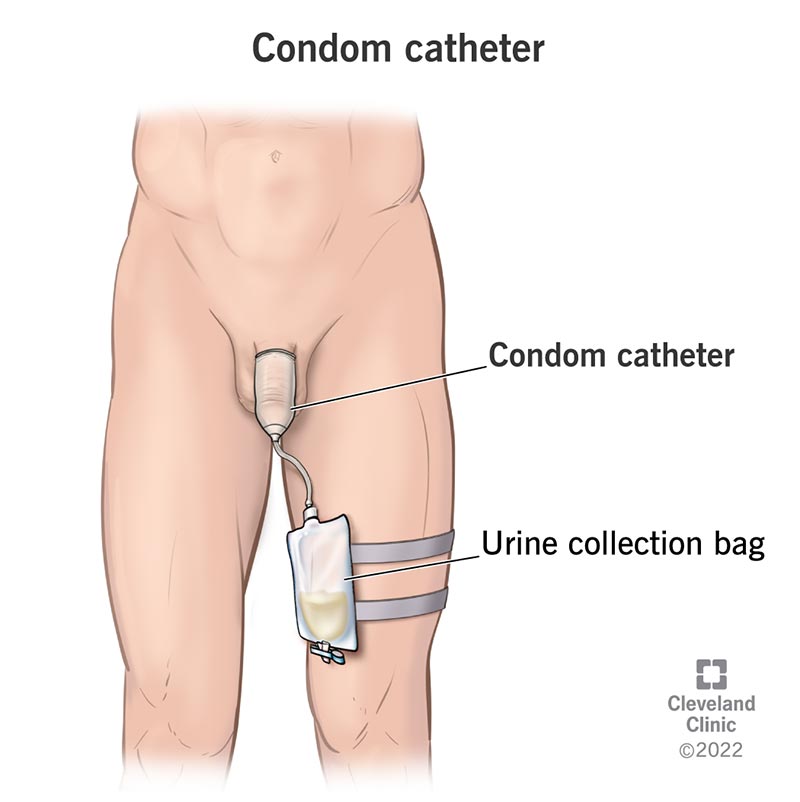Condom catheters are a type of external catheter that helps manage urinary incontinence. They fit over your penis like a condom. You should change your condom catheter every 24 hours and empty the collection bag when it’s full. You’re less likely to develop a UTI while using a condom catheter than a Foley catheter.
Advertisement
Cleveland Clinic is a non-profit academic medical center. Advertising on our site helps support our mission. We do not endorse non-Cleveland Clinic products or services. Policy

A condom catheter is a urine (pee) collection device. It fits like a condom over your penis. It has a tube at the tip that connects to a urine collection bag that you strap to your leg.
Advertisement
Cleveland Clinic is a non-profit academic medical center. Advertising on our site helps support our mission. We do not endorse non-Cleveland Clinic products or services. Policy
Condom catheters are a popular type of urinary catheter. Many males find them easier to use and change than Foley catheters (indwelling catheters). You must insert a Foley catheter through your urethra to access your urinary bladder.
There are many different names for a condom catheter. Some of them include:
Condom catheters are one of many treatment options for urinary incontinence that you can use outside of your body. Other external incontinence products include absorbent pads and underwear.
You may also use a condom catheter for other reasons, including:
You first need to choose a product. There are many kinds of condom catheters. Some use latex, while others consist of silicone. Don’t use a latex condom catheter if you have a latex allergy.
Condom catheters are also available in different sizes. You must measure around your penis (the circumference or girth) at the base of your shaft. This is where the girth is largest. You’ll use this measurement to find your size.
Advertisement
You can also choose the way you wish to apply the condom catheter. Some condom catheters are self-adhesive — they’re coated in a sticky substance that sticks to your skin. Others are non-adhesive. You secure the condom catheter in place with tape or a special type of glue that’s safe for skin.
Before you put on a condom catheter, it’s a good idea to wash your hands and penis with soap and water and gently dry them off. Otherwise, you put a condom catheter on the same way you’d put a condom on before sexual intercourse:
No, you don’t need to shave your pubic hair to use a condom catheter. But it’s a good idea to trim your pubic hair around the base of your penis to ensure the adhesive sticks to your skin.
Empty the collection bag when it’s full. You should change your condom catheter every day.
It’s important to wash your hands with soap and water every time you put a new condom catheter on or take it off. Don’t reuse catheters. If you reuse the drainage bag, be sure to wash it thoroughly.
Condom catheters have many benefits, including:
Many people also find condom catheters more comfortable than Foley catheters.
The risks or complications of condom catheters include:
Healthcare providers also may not recommend condom catheters if you have a bladder stone or you’re unable to put it on or take it off yourself.
Reach out to a healthcare provider if you have any symptoms of urinary incontinence. They’ll work with you to find the best solution for treating leaks, which may include using condom catheters.
Advertisement
Call your provider if you’re using a condom catheter and you experience any of the following symptoms:
A Texas catheter is a trademarked name for a condom catheter. Sometimes, trademarked names are of such common use that they become the generic term for the product. For example, some people refer to all brands of tissues as Kleenex® or every brand of bandage as a Band-Aid®.
There are different types of external catheters if you have a vagina.
One type covers your vulva. It comes with adjustable underwear and uses a soft, absorbent pad that drains into a collection bag.
Another type of female urinary catheter has a curved tube, like a thin banana. Absorbent wicking material covers the tube, which runs from your pubic bone to your butt (buttocks). The catheter uses a gentle vacuum and attaches to a collection container.
These catheters aren’t useful for activity, even walking. You should only use them while sitting or lying down.
Condom catheters are a popular way to help manage urinary incontinence. Many people find them easier to apply and more comfortable than other options, like Foley catheters or absorbent underwear. But it can also feel strange to know you’re using a condom catheter or that you’re storing pee in a bag strapped to your leg. You may also worry about leaks or skin irritation that can develop. These are normal feelings and concerns. But it’s a good idea to reach out to a healthcare provider if you have any questions or feel overwhelmed. They can answer any of your questions. They can also recommend a different condom catheter brand that works better for you.
Advertisement
It can be stressful (and painful) to have bladder disorders, like urinary incontinence or cystitis. But the urology providers at Cleveland Clinic are here for you.

Last reviewed on 07/10/2025.
Learn more about the Health Library and our editorial process.